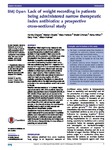Lack of weight recording in patients being administered narrow therapeutic index antibiotics: a prospective cross-sectional study
| dc.contributor.author | Charani, E | |
| dc.contributor.author | Gharbi, M | |
| dc.contributor.author | Hickson, Mary | |
| dc.contributor.author | Othman, S | |
| dc.contributor.author | Alfituri, A | |
| dc.contributor.author | Frost, G | |
| dc.contributor.author | Holmes, A | |
| dc.date.accessioned | 2018-01-22T11:44:10Z | |
| dc.date.available | 2018-01-22T11:44:10Z | |
| dc.date.issued | 2015-04-02 | |
| dc.identifier.issn | 2044-6055 | |
| dc.identifier.issn | 2044-6055 | |
| dc.identifier.other | ARTN e006092 | |
| dc.identifier.uri | http://hdl.handle.net/10026.1/10643 | |
| dc.description.abstract |
OBJECTIVES: Patient weight is a key measure for safe medication management and monitoring of patients. Here we report the recording of patient's body weight on admission in three hospitals in West London and its relationship with the prescription of antibiotic drugs where it is essential to have the body weight of the patient. METHODS: A prospective cross-sectional study was conducted in three teaching hospitals in West London. Data were collected during March 2011-September 2011 and July 2012-August 2012, from adult admissions units, medical and surgical wards. Data from each ward were collected on a single day to provide a point prevalence data on weight recording. Patient medication charts, nursing and medical notes were reviewed for evidence of weight and height recording together with all the medication prescribed for the patients. An observational study collecting data on the weight recording process was conducted on two randomly selected wards to add context to the data. RESULTS: Data were collected on 1012 patients. Weight was not recorded for 46% (474) of patients. Eighty-nine patients were prescribed a narrow therapeutic antibiotic, in 39% (35/89) of these weight was not recorded for the patient. Intravenous vancomycin was the most commonly prescribed antibiotic requiring therapeutic monitoring. In total 61 patients were receiving intravenous vancomycin and of these 44% (27/61) did not have their weight recorded. In the observational study, the most frequently identified barrier to weight not being recorded was interruptions to the admission process. CONCLUSIONS: Despite the clinical importance of body weight measurement it is poorly recorded in hospitalised patients, due to interruptions to the workflow and heavy staff workloads. In antibiotics a correct, recent patient weight is required for accurate dosing and to keep drugs within the narrow therapeutic index, to ensure efficacy of prescribing and reduce toxicity. | |
| dc.format.extent | e006092-e006092 | |
| dc.format.medium | Electronic | |
| dc.language | en | |
| dc.language.iso | eng | |
| dc.publisher | BMJ | |
| dc.subject | THERAPEUTICS | |
| dc.subject | Adolescent | |
| dc.subject | Adult | |
| dc.subject | Aged | |
| dc.subject | Anti-Bacterial Agents | |
| dc.subject | Body Weight | |
| dc.subject | Cross-Sectional Studies | |
| dc.subject | England | |
| dc.subject | Female | |
| dc.subject | Hospitals, Teaching | |
| dc.subject | Humans | |
| dc.subject | Male | |
| dc.subject | Medical Records | |
| dc.subject | Middle Aged | |
| dc.subject | Nursing Records | |
| dc.subject | Practice Patterns, Physicians' | |
| dc.subject | Prospective Studies | |
| dc.subject | Young Adult | |
| dc.title | Lack of weight recording in patients being administered narrow therapeutic index antibiotics: a prospective cross-sectional study | |
| dc.type | journal-article | |
| dc.type | Journal Article | |
| dc.type | Observational Study | |
| dc.type | Research Support, Non-U.S. Gov't | |
| plymouth.author-url | https://www.webofscience.com/api/gateway?GWVersion=2&SrcApp=PARTNER_APP&SrcAuth=LinksAMR&KeyUT=WOS:000352143400010&DestLinkType=FullRecord&DestApp=ALL_WOS&UsrCustomerID=11bb513d99f797142bcfeffcc58ea008 | |
| plymouth.issue | 4 | |
| plymouth.volume | 5 | |
| plymouth.publication-status | Published | |
| plymouth.journal | BMJ Open | |
| dc.identifier.doi | 10.1136/bmjopen-2014-006092 | |
| plymouth.organisational-group | /Plymouth | |
| plymouth.organisational-group | /Plymouth/Faculty of Health | |
| plymouth.organisational-group | /Plymouth/Faculty of Health/School of Health Professions | |
| plymouth.organisational-group | /Plymouth/REF 2021 Researchers by UoA | |
| plymouth.organisational-group | /Plymouth/REF 2021 Researchers by UoA/UoA03 Allied Health Professions, Dentistry, Nursing and Pharmacy | |
| plymouth.organisational-group | /Plymouth/Research Groups | |
| plymouth.organisational-group | /Plymouth/Research Groups/Institute of Health and Community | |
| plymouth.organisational-group | /Plymouth/Research Groups/Plymouth Institute of Health and Care Research (PIHR) | |
| plymouth.organisational-group | /Plymouth/Users by role | |
| plymouth.organisational-group | /Plymouth/Users by role/Academics | |
| dc.publisher.place | England | |
| dc.identifier.eissn | 2044-6055 | |
| dc.rights.embargoperiod | Not known | |
| rioxxterms.versionofrecord | 10.1136/bmjopen-2014-006092 | |
| rioxxterms.licenseref.uri | http://www.rioxx.net/licenses/all-rights-reserved | |
| rioxxterms.type | Journal Article/Review |


